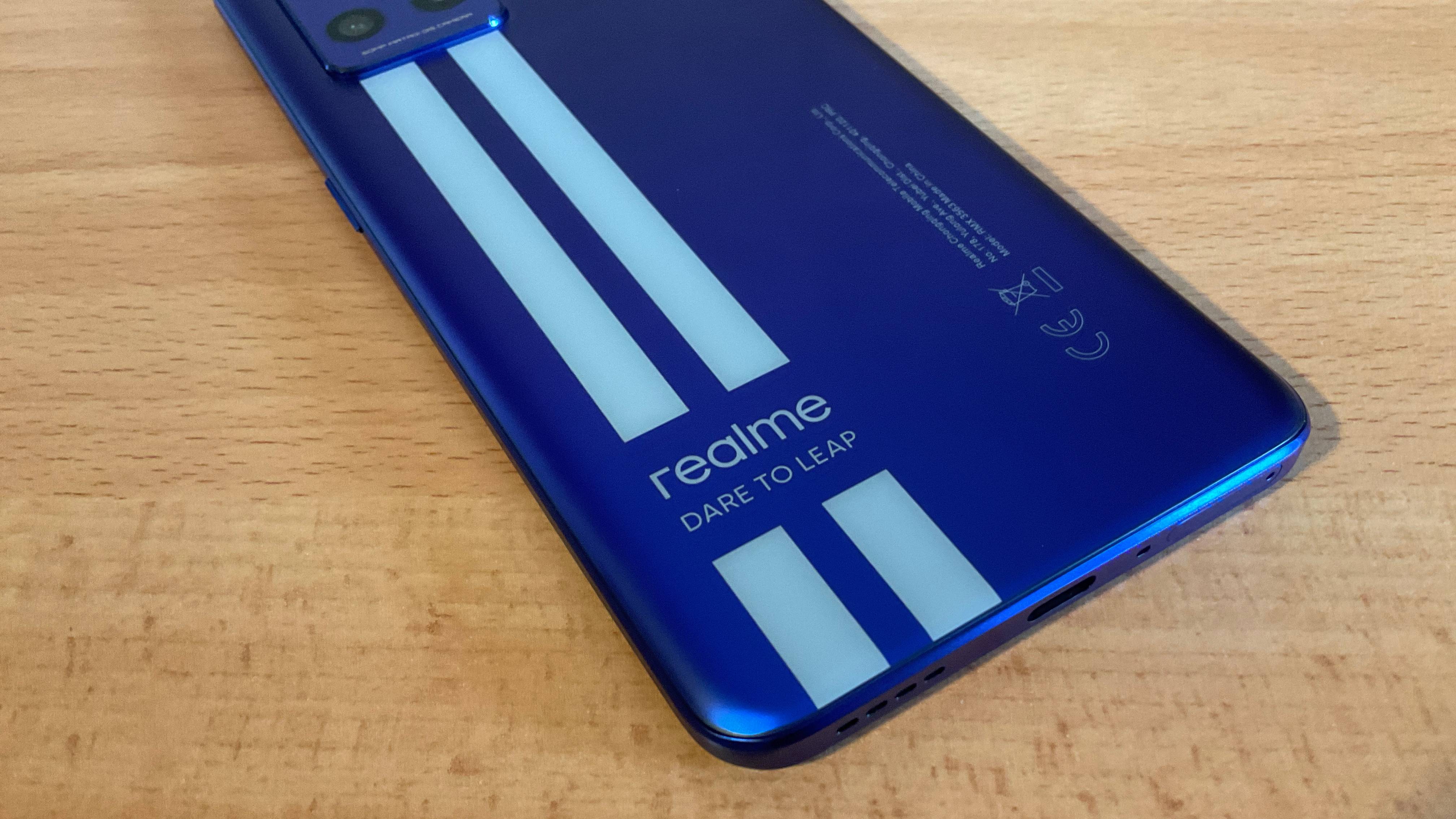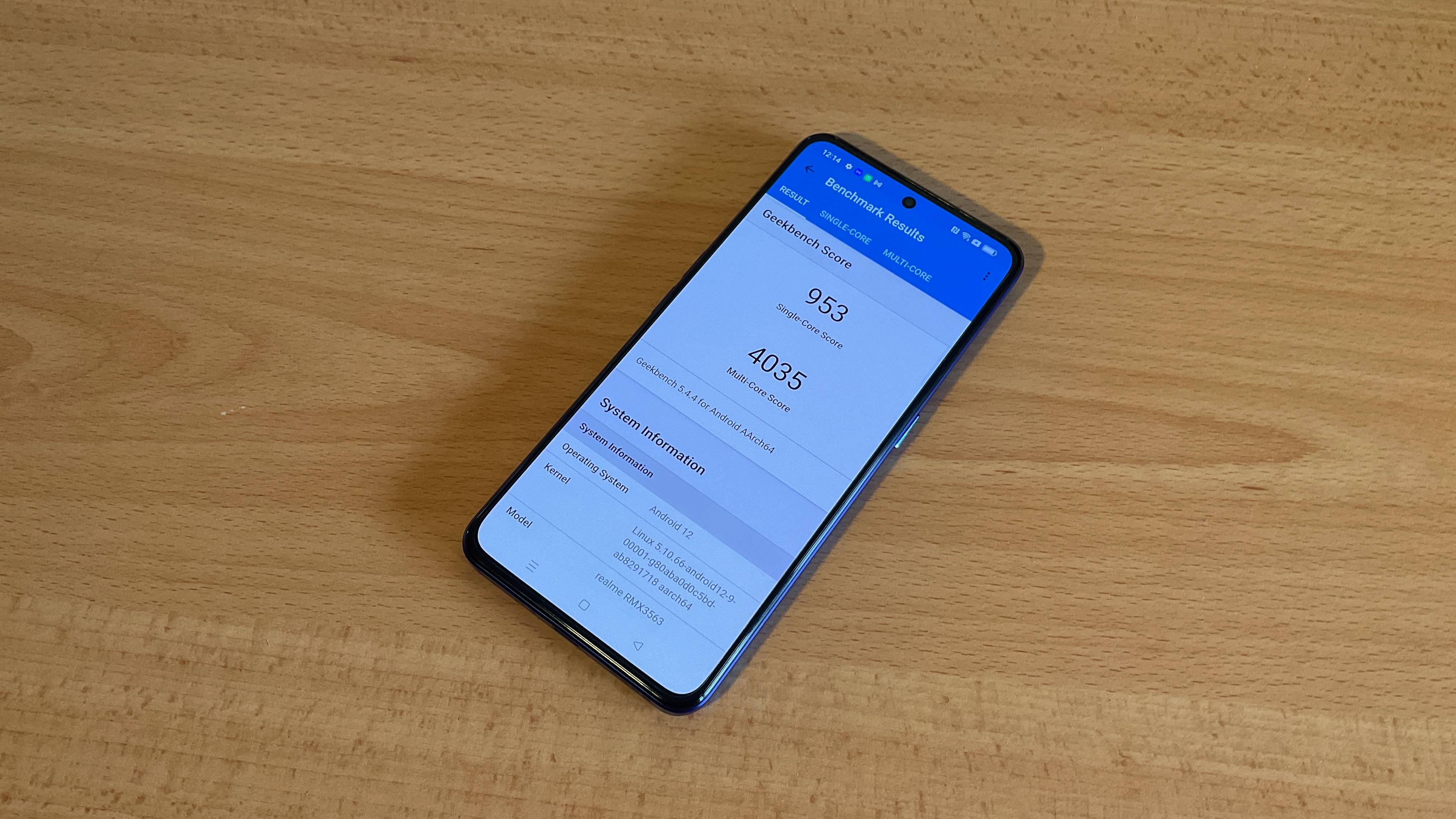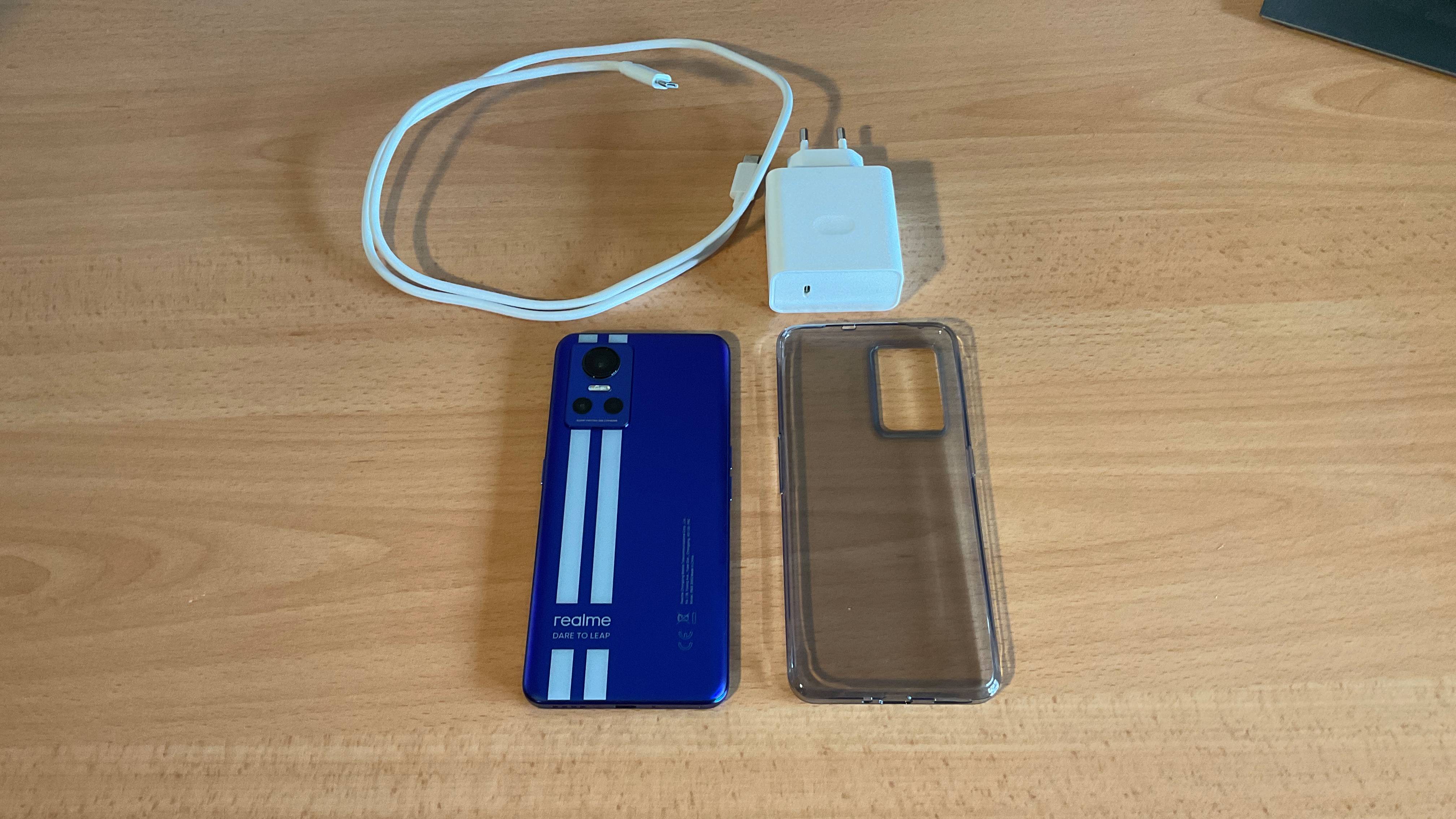Laptop Mag Verdict
The Realme GT Neo 3 delivers surprising processing power in the MediaTek Dimensity 8100 5G and ridiculously fast 150W charging speeds, but it comes at a cost.
Pros
- +
Surprising performance
- +
Beautiful 120Hz AMOLED display
- +
Blazing fast charging speeds
- +
Decent main camera
Cons
- -
Polarizing design
- -
No headphone jack
- -
£599 price tag
Why you can trust Laptop Mag
Price: £599
OS: Android 12/ Realme UI 3.0
Display: 6.7-inch 120Hz AMOLED
CPU: MediaTek Dimensity 8100 5G
RAM: 12GB
Rear cameras: 50MP Sony IMX766 OIS wide (f/1.88), 8MP ultrawide (f/2.25), 2MP macro (f/2.4)
Front camera: 16MP (f/2.45)
Storage: 256GB
Battery: 4,500mAh (2 x 2,250mAh)
Weight: 6.4 ounces
Mid-range phones have been keeping up with their flagship competition for a while now, and Realme is at the forefront of delivering killer features without draining bank accounts. Bright, 120Hz AMOLED displays with vivid colors, Sony-made 50MP cameras with 4K video capture and small touches like an under-display fingerprint reader are quickly becoming the norm. So, what’s next?
A ridiculously fast 150W charging speed, that’s what. That kind of charging speed on a smartphone is nothing to sneeze at, and the Realme GT Neo 3 150W wears it proudly on its sleeve. To put that into perspective, the recent Xiaomi 12 Pro made waves by offering 120W charging. Now, the GT Neo 3 speeds by with a 150W UltraDart Charge at half the price — leaving tail lights in its wake.
That racing reference wasn’t for naught, as Realme has designed its phone around speed; from its racing stripes to its surprisingly fast processor. But just like racing cars, it might be on the pricier side of mid-range phones due to its horsepower. Does the GT Neo 3 150W do enough to earn its stripes? Let's find out.
Realme GT Neo 3 price and configurations
The Realme GT Neo 3 comes in a couple of configurations, including an 80W SuperDart Charge model with a Snapdragon 870 processor and a 150W UltraDart Charge model with a MediaTek Dimensity 8100 5G CPU. We got our hands on the latter, and it’s now available in the UK and Europe for £599 (around $750).
Compared to the £349 Realme 9 Pro+ released earlier this year, the GT Neo 3 is much pricier but packs better specs. The $326/£259 Poco X4 Pro 5G and $329/£319 Xiaomi Redmi Note 11 Pro 5G offer better competition, with similar features, bar the 150W charging speeds. While pricier, Realme strives to offer more reason to opt for the GT Neo 3, with its surprisingly good Dimensity 8100 5G CPU and it’s “first dedicated display processor.” However, the $599/£499 Google Pixel 6 is cheaper, and offers a range of software and updates that Realme will find hard to beat.
The Realme GT Neo 3T with 80W charging and a Snapdragon 870 5G will save you quite a bit as it’s available for just £369.
Realme GT Neo 3 design
Are you a fan of Gran Turismo 7 or motor racing in general? You’ll be keen on the the racing stripes and checkered flags on the Realme GT Neo 3. It’s inspired by motor racing and the true story of Carroll Shelby, a American automotive designer and racing driver, who painted track stripes on a high-end sports car.
It’s a little on the nose. We get that the phone has wicked fast charging, but does the rest of it need to be centered around that theme? That depends on your style. But the good news is you don’t have to opt for racing stripes, as there is a simple Asphalt Black option.
We received the Nitro Blue model, but there’s also a Sprint White model with black stripes too. I’m a fan of the strikingly blue back cover and sleek white stripes, as it shares a resemblance with a car like a blue Ford Mustang Shelby GT500. It’s similar to a design of a special edition smartphone, like the Smasung Galaxy Z Flip Thomas Browne edition, except without the extra cost.
There’s still Realme’s “Dare To Leap” catchphrase emblazoned on the back, but it’s not nearly as gaudy as the one found on the Realme 8 Pro. The racing stripes run under the slight camera bump, with the glass finish delivering a shiny yet fingerprint-prone metallic blue.
Flip it over and you’ll find a small hole-punch camera placed at the top centre of the display, along with a thin 94% screen-to-body ratio. It looks sleek, especially with its rounded edges, and is nice and light to pick up and handle. Coming in at 6.4 ounces with dimensions of 6.4 x 2.9 x 0.3 inches, the GT Neo 3 is a decently sized Android phone, especially if you’re looking to stream movies and play games. Compared to the Redmi Note 11 Pro+ (6.4 x 2.9 x 0.3 inches, 7 ounces), Realme GT 2 (6.4 x 2.9 x 0.3 inches and 6.9 ounces), and Poco X4 Pro (6.4 x 2.9 x 0.3, 7.4 ounces), the GT Neo 3 is a real lightweight.
Sign up to receive The Snapshot, a free special dispatch from Laptop Mag, in your inbox.
Realme GT Neo 3 display
I expected nothing less of the Realme GT Neo 3’s 6.7-inch FHD+ (2412 x 1080) AMOLED Reality Display, featuring eye-popping colors and a bright screen in an attractive, near bezel-less layout. I did say I wanted a high screen-to-body ratio, and Realme delivered. In fact, Realme states it uses a new generation of COP packaging process, meaning we could see less chin in future Realme phones.
To put it to the test, I turned to the latest episode of Obi-Wan Kenobi on Disney+ to witness the reckless clash of his blue Lightsaber against the foreboding might of Darth Vader’s red Lightsaber. The epic clash of red and blue light under a night sky was a delight to watch, with fluid beams whirling around across the display as our beloved Jedi fumbles. Poor Ben Kenobi.
The brilliance of colors and contrasts between lights and darks was expected, though. The GT Neo 3 supports 100% DCI-P3 color gamut coverage, HDR10+, and boasts 10-bit color depth. There’s also the option to turn on a “Bright HDR video mode, brightening the screen when playing HDR videos, along with an auto-refresh rate ranging from 120Hz to 60Hz depending on the app. You bet scrolling through apps offered a buttery smooth experience.
The display’s smooth refresh rate and vivid colors are reflected in gaming, too. The display showed off the various landscapes found in Apex Legends Mobile, although the game automatically recommended I go to HD graphic quality, albeit with a High refresh rate.
All in all, I was impressed by the GT Neo 3’s display. It’s bright enough when used outdoors, claimed to reach 800 nits of brights, and it’s color accuracy is top-notch. Realme states it now has an independent display chip powering extremely smooth, high-quality pictures in motion, but I’m not sure if I noticed this through the games and shows I watched.
Realme GT Neo 3 audio
The sound of Lightsabers buzzing with condensed energy and screeching as the clash is iconic, and the GT Neo 3’s speakers do a fair job of expressing this sound. That’s thanks to the dual stereo speakers that also support Hi-Res audio and Dolby Atmos. They don’t offer crisp detail or loud volume, but they do a decent job when watching shows or listening to music.
As you might have guessed, I tested them out while watching Obi-Wan Kenobi, but I also turned on a drum-heavy “The Death & Ressurection Show” by Killing Joke. It features Foo Fighter’s Dave Grohl on drums, and he absolutely smashes each beat. The drums sound overpowering compared to the monotone voice of Jaz Coleman and the deep guitar sturms. In fact, I heard the “Tsch” of the hit-hat sound more pronounced than anything else. Still, I could definitely rock out to it.
I then tried “21 Reasons” by Nathan Dawe featuring Ella Henderson for something more “house party.” I was impressed by the slight bass playing in tandem with the clear vocals of Henderson, and the saxophone made itself known with its memorable tune.
The downside to all this? There’s no audio jack. I know smartphone speakers are handy, but more often than not, people don’t want to blast what they’re listening to for all to hear. Look, I adore heavy tunes, but not everyone else does. A headphone jack is needed, even in a world of wireless headphones and wireless earbuds.
Realme GT Neo 3 performance
The Realme GT Neo 3 is equipped with a Mediatek Dimensity 8100 5G octa-core CPU with a 5nm process, along with 12GB of RAM and 256GB of storage. It’s surprising to see this chip, seeing how the Realme GT 2 sports a powerful Snapdragon 888 CPU. But more surprising is how well this chip performs.
As always, I put the GT Neo 3 through its paces by opening a couple of dozen active Google Chrome tabs while watching Obi-Wan Kenobi on Disney+ in a small window. I also slipped between the Chrome tabs and Apex Legends Mobile to see how fast it could switch between the two. Not a hiccup in sight. Better yet, the 120Hz refresh rate meant sliding between different apps and scrolling through websites a smooth experience.
In the Geekbench 5 test, the Realme GT Neo 3 delivered a multi-core score of 4,035, which blazes past the Poco X4 Pro (Snapdragon 695 5G, 2,052), Realme 9 Pro+ (MediaTek Dimensity 920, 2,318), and OnePlus Nord 2 (Mediatek Dimensity 1200-AI, 2,697). It even does exceedingly well against the Realme GT 2 (Snapdragon 888, 3,562), and, more surprisingly, against the Xiaomi 12 Pro (Snapdragon 8 Gen 1, 3,783), Galaxy S22+ (Snapdragon 8 Gen 1, 3,361) and Pixel 6 Pro (Google Tensor, 2,760). Good for you, MediaTek.
In the 3DMark Wild Life Unlimited test, the GT Neo 3 clocked an overall score of 5,231 with an average frame rate of 31.3. Not bad at all compared to the Poco X4 Pro (7 fps) and Redmi Note 11 Pro+ (7.3 fps), and only a smidgen behind the Realme GT 2 (35 fps). It doesn’t do as well compared to flagships like the Xiaomi 12 Pro (61 fps), but it still holds it own when gaming.
For a mid-range phone, these are very impressive specs; even beating out its flagship Snapdragon 8 Gen 1 rivals. You’ll be able to throw a lot at the GT Neo 3.
Realme GT Neo 3 battery life and charging
This is the Realme GT Neo 3’s biggest selling point, boasting a 150W UltraDart Charge that claims to achieve a 50% charge in 5 minutes. I mean, that’s stupid fast, and makes you wonder if the phone might spontaneously burst into flames. Safe to say no fire extinguisher was needed, as the GT Neo 3 doesn’t even get too warm when charging at these speeds.
The GT Neo 3 is equipped with a 4,500mAh battery capacity (2 x 2,250mAh batteries), which is surprising considering the phone’s selling point. However, the battery still lasted a day with heavy usage, which included watching YouTube videos and Disney+ shows, playing Call of Duty: Mobile, scrolling through social media, snapping pictures and shooting video, along with phone calls and messaging. With moderate usage, I could easily squeeze a second day out of this phone.
Not that it matters, though. Plugging this into the sizeable 150W power brick zaps it with juice in no time. I tested out the 5-minute claim, and as you can see, it doesn’t quite reach that expectation. But it did do just over 30% in 5 minutes, which is impressive enough. I left it on for a further 10 minutes, and it had reached 100% before I picked it up. Now that’s fast. It’s a huge plus, and it means making sure your phone is charged up only takes a few mintues out of your day.
Realme included the same tweaks to its software to make the phone last longer, including an App Quick Freeze feature for when apps are not in use, along with a power-saving mode and a super power-saving mode. There’s also optimised night charging to avoid overcharging at night, along with a GT Performance mode that sacrifices battery for optimal performance, especially in games.
Realme GT Neo 3 cameras
The Realme GT Neo 3 has the same camera system as the Realme 9 Pro+, and that’s not such a bad thing. We would like to see improvements with the ultrawide and macro lens, especially seeing as the phone is pricier, but I’m happy with the 50-megapixel Sony IMX766 camera with optical image stabilisation (OIS) as its main sensor. That’s seemingly a step down from the 108MP main shooter found on phones like the Redmi Note 11 Pro or Poco X4 Pro, but megapixels aren’t everything and it’s taken a few tips from the OnePlus Nord 2’s great camera and used the same Sony IMX766 camera.



Altogether, the GT Neo 3 is equipped with a 50MP Sony IMX766 OIS wide with an f/1.8 aperture, an 8MP ultrawide with f/2.3, and a 2MP macro with an f/2.4 aperture. Again, Realme uses the same ultrawide and macro as the now aging Pro 8, so it may be time to switch this up. The three lenses work in tandem on the easy-to-use camera app, where users can switch between lenses to best suit the environment. I’m a fan of the crisp detail produced by the main shooter, offering true colours and great contrast in the snaps I took.



Thankfully, we’re now in spring, which means sunny days are more frequent. I decided to go on my walk near the canal, snapping what I could see at various distances. Each snap delivered rich detail of the canal boats mooring for the season, along with the blue sky coming through in the back. The 119-degree ultrawide does a good job of capturing wide angles while still offering clear detail, although the colours from the ultrawide and macro lenses were a little off when compared to the main sensor.
I also messed about with the “Street Photography Mode,” which allows you to hold down the shutter button to zoom in or out, capture stylish photos thanks to smart long exposure, and offers a 90s pop filter. It isn’t the mode I would immediately go to, but for those that like trying out different shots, it’s a nice addition.
The cameras also support 4K at 30 fps or 1080p at up to 60 fps. The videos I shot were average, and aren’t anything to write home about. It’s the same quality found on Realme smartphones at prices under £350, so it would have been nice to see an upgrade. Finally, there’s also a 16MP front-facing camera capable of capturing a decent amount of detail, right down to the stray strands of facial hair.
Realme GT Neo 3 software
Using Realme UI 3.0 overlaid on Android 12, you’ll find a number of ways to personalise the Realme GT Neo 3. This is similar to what the Oppo Find X3 Pro offers, which allows you to change everything from the fingerprint sensor styles to adding an always-on display that includes the return of “realmeow.” The cyborg kitty is growing on me, I suppose.
There’s also edge lighting and fancy fingerprint animations. Speaking of, Realme decided to add a heart rate measurement feature to the fingerprint sensor. It’s a nice addition if you need to measure your/someone’s heart rate, but since it's deep in settings, I feel it’s more of a gimmick rather than a standout feature of the device. You’ll make better use out of Google Lens in the camera app.
With a budget phone, there’s bound to be some bloatware taking up space. However, I didn’t find too many already installed on the device when I first started it up. Sure, there’s the Amazon app, along with Booking.com and Realme’s own weather and music apps, but these weren’t a hindrance when compared to other budget smartphones that constantly remind you to update apps you never use.
As you’ll find in our Android 12 review, we’re fans of Google’s latest OS, and it’s great to see this system already updated as soon as you take the Realme GT Neo 3 out of the box.
Realme GT Neo 3: Bottom line
Realme’s GT Neo 3 150W is all about speed, from its racing stripes to its wicked charging speeds. Does it earn those stripes? With the flagship-level MediaTek Dimensity 8100 racing past a lot of its competitors and battery life hardly being an issue, it certainly does. But a mid-range smartphone that lacks camera upgrades from its more affordable siblings and other flagship software features holds it back.
While it isn’t the best phone around for high-quality gaming, it can still hold its own without feeling like it's not built just for gamers. Plus, Realme continues to impress with its 120Hz AMOLED display, although it would have been nice to see a headphone jack.
The Real GT Neo 3 is a fantastic Android phone, especially if you’re looking for some flagship features without paying top dollar for them. For a mid-range phone, it’s a little on the pricey side, which is especially apparent compared to the $599/£499 Google Pixel 6.

Darragh Murphy is fascinated by all things bizarre, which usually leads to assorted coverage varying from washing machines designed for AirPods to the mischievous world of cyberattacks. Whether it's connecting Scar from The Lion King to two-factor authentication or turning his love for gadgets into a fabricated rap battle from 8 Mile, he believes there’s always a quirky spin to be made. With a Master’s degree in Magazine Journalism from The University of Sheffield, along with short stints at Kerrang! and Exposed Magazine, Darragh started his career writing about the tech industry at Time Out Dubai and ShortList Dubai, covering everything from the latest iPhone models and Huawei laptops to massive Esports events in the Middle East. Now, he can be found proudly diving into gaming, gadgets, and letting readers know the joys of docking stations for Laptop Mag.














